Insight Net - GRADI Online Tipiṭaka Riċerka u Prattika Università u
NEWS relatati permezz ta ‘http://sarvajan.ambedkar.org f’105 LINGWI
KLASSIĊI Paṭisambhidā
Jāla-Abaddha Paripanti Tipiṭaka Anvesanā ca Paricaya Nikhilavijjālaya
ca ñātibhūta Pavatti Nissāya http://sarvajan.ambedkar.org anto 105
Seṭṭhaganthāyatta Bhāsā huwa kanal tal-aħbarijiet onlajn
Ikel għal aktar minn 3000 Emails:
200 WhatsApp, Facebook u Twitter. https://dhammawiki.com/index.php/1-10_early_to_recent_Chronology_of_Pali_Canon https://dhammawiki.com/…/1-10_early_to_recent_Chronology_of …
1-10 kmieni għall-Kronoloġija reċenti ta ‘Pali Canon Thomas
William Rhys Davids fl-Indja Buddista tiegħu (p. 188) ta tabella
kronoloġika tal-letteratura Buddista mill-ħin tal-Buddha sal-ħin ta
‘Ashoka li huwa kif ġej: 1.
Id-dikjarazzjonijiet sempliċi tad-duttrina Buddista issa nstabu,
f’kelmi identiċi, f’paragrafi jew versi rikurrenti fil-kotba kollha. 2. Episodji misjuba, bi kliem identiċi, f’żewġ jew aktar mill-kotba eżistenti. 3. Il-Silas, il-Parayana, l-Octades, il-Patimokkha. 4. Il-Digha, Majjhima, Anguttara u Samyutta Nikayas. 5. Is-Sutta Nipata, it-Thera u Theri Gathas, il-Udanas, u l-Khuddaka Patha. 6. Is-Sutta Vibhanga, u Khandhkas. 7. Il-Jatakas u d-Dhammapadas. 8. Niddesa, Itivuttakas u Patisambbhida. 9. Il-Peta u Vimana-Vatthus, l-Apadana, il-Cariya-Pitaka, u l-Buddhavamsa. 10. Il-kotba Abhidhamma; l-aħħar waħda hija l-Katha-Vatthu, u l-aktar kmieni probbabilment il-Puggala-Pannatti. Dawk
elenkati fil-quċċata jew ħdejn il-quċċata, bħan-numri minn ħamsa sa
ħamsa, huma kkunsidrati bħala l-aktar testi qodma, eqdem u l-iktar
probabbli li jkunu awtentiċi u l-kliem eżatt tal-Buddha. It-testi
ta ‘wara u l-kummentarji u l-Visuddhimagga huma miżmuma bi stima għolja
ħafna mill-Theravada Klassika, filwaqt li t-Theravada Moderna tiffoka
fuq it-taghlim bikri tal-Buddha.
Theravada Moderna Artikolu prinċipali: Theravada Moderna Bhikkhu
Bodhi, Dhammavuddho Thera u oħrajn għandhom id-dubji tagħhom, kif
jagħmlu studjużi moderni dwar it-testi ta ‘wara u jekk huma Buddhavacana
(kliem eżatt ta’ Buddha) jew le. Theravadins Moderna probabilment għandhom varjetà żgħira ta ‘opinjonijiet iżda probabilment jieħdu waħda minn dawn li ġejjin: 1.
L-ewwel erba Nikayas fl-intier tagħhom huma Buddhavacana, flimkien
mal-kotba li ġejjin mill-Khuddaka Nikaya: Dhammapada, Udana, Itivuttaka,
Sutta Nipata, Theragatha u Therigatha; u l-Patimokkha mill-Vinaya. (Dan xorta jagħmel il-porzjon Buddhavacana tat-Tipitaka bejn wieħed u ieħor 30 minn 40 volum). 2.
Kollha ta ‘hawn fuq, flimkien mal-kotba l-oħra tal-Khuddaka Nikaya,
flimkien mal-kotba Vinaya oħra, flimkien mal-Abhidhamma, iżda jarawhom
kif miktub minn dixxipli posterjuri tal-Buddha, li setgħu kienu arahants
u għalhekk, xorta jistħoqqilhom inkluż fil-Canon, għalkemm mhux probabbli parti mill-Buddiżmu Oriġinali. Il-patrijiet
akkademiċi Ajahn Sujato u Ajahn Brahmali kitbu l-ktieb The Authenticity
of Early Buddhist Texts u huma jaqblu man-numru wieħed t’hawn fuq, li
jikkonsisti mill-ewwel 4 Nikayas u xi wħud mill-Nikka Khuddaka bħala
Buddhavacana. Ara wkoll: Buddiżmu Oriġinali
Referenzi Il-Ktieb sħiħ tal-Listi ta ‘Buddha - Spjegat. David N. Snyder, Ph.D., 2006.
http://www.thedhamma.com/
L-Awtentiċità tat-Testi Buddisti Bikrija Is-Soċjetà Buddista tal-2014.
https://suttacentral.net/
dhammawiki.com
1-10 kmieni għall-Kronoloġija reċenti ta ‘Pali Canon - Dhamma Wiki
Thomas
William Rhys Davids fl-Indja Buddista tiegħu (p. 188) ta tabella
kronoloġika tal-letteratura Buddista mill-ħin tal-Buddha sal-ħin ta
‘Ashoka li huwa kif ġej:
https://www.youtube.com/watch?v=1K__1scyaiA
THE FIRST SERMON
Benoy Behl
Published on May 4, 2009
Category
Film & Animation
https://www.youtube.com/watch?v=za0Df22bTL0
The Voice of the Buddha
Benoy Behl
Published on Jul 22, 2014
Film about the International Tripitaka Chanting and other activities of the Light of Buddhadharma Foundation.
Category
Film & Animation
Insight Net - Tipiṭaka Research Online me te Practice Wharerangi me nga
korero e pā ana mai i http://sarvajan.ambedkar.org i roto i te 105
WHAKANUI KAUPAPA Paṭisambhidā
Jāla-Abaddha Paripanti Tipiṭaka Anvesanā ca Paricaya Nikhilavijjālaya
ca ñātibhūta Pavatti Nissāya http://sarvajan.ambedkar.org anto 105
Seṭṭhaganthāyatta Bhāsā Ko te NEW NEW CHANNEL
Te mahi ki nga neke atu i te 3000 Miihini:
200 WhatsApp, Facebook me Twitter. https://dhammawiki.com/index.php/1-10_early_to_recent_Chronology_of_Pali_Canon https://dhammawiki.com/…/1-10_early_to_recent_Chronology_of…
1-10 i te tīmatanga o te Chronology o Pali Canon Ko
Thomas William Rhys Davids i roto i tana Buddhist India (p. 188) kua
hoatu he ripanga o nga pukapuka Buddhist mai i te wa o Buddha ki te wa o
Ashoka e penei: 1.
Ko nga korero o te whakaakoranga Buddhist kua kitea inaianei, i roto i
nga kupu rite, i roto i nga paraka, nga ira ranei e mau ana i roto i nga
pukapuka katoa. 2. I kitea nga pukapuka i roto i nga kupu rite, i roto i nga pukapuka e rua, neke atu ranei. 3. Ko Hira, ko Parayana, ko Octades, ko Patimokkha. 4. Ko Digha, Majjhima, Anguttara, me Samyutta Nikayas. 5. Ko te Sutta Nipata, ko Thera, ko Theri Gathas, ko Udanas, ko te Khuddaka Patha. 6. Ko te Sutta Vibhanga, ko Khandhkas. 7. Nga Jatakas me nga Dhammapadas. 8. Te Niddesa, te Itivuttakas me te Patisambbhida. 9. Ko te Peta me te Vimana-Vatthus, te Apadana, te Cariya-Pitaka, me te Buddhavamsa. 10. Ko nga pukapuka Abhidamama; ko te whakamutunga ko te Katha-Vatthu, ko te tuatahi ko Puggala-Pannatti. Ko
nga mea kua whakaruarangitia ki runga, e tata ana ranei ki runga, e
rite ana ki te tau kotahi ki te rima, ka whakaarohia ko nga timatanga,
ko nga tuhinga tawhito, me te mea pea he pono, me nga kupu tika a
Buddha. Ko
nga tuhinga o muri mai, me nga korero me nga Visuddhimagga, kei te tino
nui te ahua o te Classical Theravada, engari ko te Modern Theravada te
arotahi ki nga whakaakoranga tuatahi a Buddha.
Modern Theravada Tuhinga matua: Modern Theravada Ko
Bhikkhu Bodhi, ko Dhammavuddho Thera me etahi atu he ruarua, he rite
hoki nga tohunga hou mo nga tuhinga o muri mai, me te mea he
Buddhavacana (nga kupu tika o Buddha), ehara ranei. He maha nga whakaaro o te Theravadins Modern kaore pea e whai ake nei: 1.
Ko Nikayas tuatahi tuatahi ko Buddhavacana, me nga pukapuka e whai ake
nei mai i te Khuddaka Nikaya: Dhammapada, Udana, Itivuttaka, Sutta
Nipata, Theragatha, me Therigatha; me te Patimokkha i te Vinaya. (Ka waiho tonu te waa Buddhavacana o te Tipitaka i te 30 o nga 40 o nga pukapuka.) 2.
Ko nga mea katoa o runga ake, me era atu pukapuka o te Khuddaka Nikaya,
me era atu pukapuka Vinaya, me te Abhidhamma, engari ka kite ia ratou i
tuhia e nga akonga o muri mai o te Buddha, he tangata kua awhina, me te
mea he tika tonu kia waiho hei kei roto i te Canon, ahakoa kaore he waahanga o te Buddhism taketake. Kua
tuhia e te karauna moemoea Ajahn Sujato me Ajahn Brahmali te pukapuka
Ko te Pono o nga Pukapuka Buddhist Early, a he rite ki te tau kotahi i
runga ake, ko te Nikayas tuatahi me etahi o nga Khuddaka Nikaya ano ko
Buddhavacana. Titiro hoki: Ko te Buddhism taketake
Nga korero Ko te Puka Tuhituhi o nga Pukapuka a Buddha - Kua Whakamahia. David N. Snyder, Ph.D., 2006.
http://www.thedhamma.com/
Ko te Motuhake o nga Pukapuka Buddhist Early Buddhist Publication Society, 2014.
https://suttacentral.net/
dhammawiki.com
1-10 i te tīmatanga o te Chronology o Canon Canon - Dhamma Wiki
Ko
Thomas William Rhys Davids i roto i tana Buddhist India (p. 188) kua
hoatu he ripanga o nga pukapuka Buddhist mai i te wa o Buddha ki te wa o
Ashoka e penei:

https://www.youtube.com/watch?v=OO8nE–a5yg
Traditional Tattoos: Fang Od and Kalinga Tattooing in the Philippines
Wade Shepard
Published on Jan 8, 2014
My gear:
Big camera: http://amzn.to/2hHXIVb
Small camera: http://amzn.to/2zpLFnA
Drone: http://amzn.to/2ieAGsW
Gimbal camera: http://amzn.to/2hIirIk
Action cam: http://amzn.to/2xIkoj3
Favorite lens: http://amzn.to/2yqRJhC
Sound recorder: http://amzn.to/2kO17X6
Fang Od is part of the last line of traditional Kalinga tattoo artists
in the Philippines. It was assumed for a while that the now 93 year old
Fang Od would be the last, but her granddaughter has taken up the art
and the traditional continues. This type of authentic tribal tattooing
was once done for head hunters and to beautify women, who would be able
to take their tattoos with them in the after life. Find out more about
traditional Kalinga Philippines tattooing at http://www.vagabondjourney.com/fang-o….
To purchase full resolution clips of this video contact Vagabondsong [at] gmail.com
“Vagabond Journey: A Global Nomad Since 1999″
Subscribe to channel: http://tinyurl.com/subscribe-vagabond…
Visit site: http://www.vagabondjourney.com
Follow Vagabond Journey:
Subscribe: http://www.vagabondjourney.com/feed/
Facebook: https://www.facebook.com/vagabondjour…
Twitter: https://twitter.com/vagabondjourney
Google Plus: https://plus.google.com/u/0/+WadeShepard
Pinterest: http://www.pinterest.com/vagabondjour…
LinkedIn: http://www.linkedin.com/in/wadeshepard
Category
Travel & Events
इनसाइट नेट - विनामूल्य ऑनलाइन टिपिका रिसर्च अँड प्रॅक्टिस युनिव्हर्सिटी
आणि संबंधित न्यूज: http://sarvajan.ambedkar.org वर 105 क्लासिक
भाषांमध्ये पिसिम्भदा
जाल-अबपा पिपंती टिपिका अवेसाणा सीए परिकया निखिलविजलया सी एन टीभुवत
पवत्ती निसाया http://svajan.ambedkar.org anto 105 संथागत्य भासा एक ऑनलाईन वृत्तपत्र आहे
3000 पेक्षा जास्त ईमेल्ससाठी कॅटरिंग:
200 व्हाट्सएप, फेसबुक आणि ट्विटर https://dhammawiki.com/index.php/1-10_early_to_recent_Chronology_of_Pali_Canon https://dhammawiki.com/…/1-10_early_to_recent_Chronology_of…
पाली कॅननच्या कालखंडातील आपल्या
बौद्ध भारत (थॉमस 188) मध्ये थॉमस विल्यम राईस डेव्हिड्स यांनी बुद्धकालीन
काळापासून अशोकच्या काळातील बौद्ध साहित्याचा कालानुक्रमिक टेबल दिला आहे: बौद्ध सिद्धांतातील साध्या विधाने आता सर्व पुस्तकात पुनरावृत्त परिच्छेद किंवा अध्याय मध्ये समान शब्दांत आढळतात. 2. एपिसोडचे दोन किंवा त्यापेक्षा जास्त पुस्तके एकसारखे शब्द आहेत. 3. सिलास, परिण, ऑक्टेट्स, पाटीमोक दिघा, माजजिमा, अंगुत्तारा आणि समुत निकय्या. 5. सुत्ता निपत, थेरा आणि थेरथ, आठवत, आणि खुडका पथ. 6. सुत्त विभंगा व खांडके. 7. जटाका आणि धम्मपदास. 8. निदेशास, इतिवत्तकास आणि पतिसंबभड्डा 9. पेटा आणि विमन-वत्थस, अपदाना, करिया-पितका आणि बौद्धवंसा. 10. अभिनव पुस्तके; जे शेवटचे आहे ते कथा-वाथू, आणि सर्वात आधी कदाचित पुगल-पन्नट्टी. शीर्षस्थानी
किंवा शीर्षस्थानी सूचीबद्ध केलेले, जसे की संख्या एक ते पाच, हे सर्वात
जुने, जुने ग्रंथ समजले जातात आणि ते प्रामाणिक असण्याची आणि बुद्धांच्या
अचूक शब्दांची जास्त शक्यता असते. नंतरचे
ग्रंथ आणि टीपा आणि विसचिहिमग्गा हे प्राचीन थिवाडाने अतिशय आदराने ठेवले
आहेत, तर आधुनिक थिवाडांनी बुद्धांच्या सुरुवातीच्या शिकवणींवर लक्ष
केंद्रित केले आहे.
आधुनिक थेरवडा मुख्य लेख: आधुनिक थेरवाद नंतरच्या
ग्रंथांविषयी आधुनिक विद्वान म्हणून भिक्खु बोधी, धम्मुंदु थ्रा आणि
इतरांच्या मनात शंका आहेत आणि जर ते बुद्धवचन आहेत (बुद्धांच्या अचूक शब्द)
किंवा नाहीत तर आधुनिक Theravadins कदाचित मते एक किंचित विविध धारण पण कदाचित खालील पैकी एक घेऊन: 1.
त्यांच्यातील पहिले चार नाकाय हे बुद्धवचन आहेत, तसेच खालील पुस्तके
खादुका निकियामा: धम्मपद, उदाना, इतिवत्तक, सुत्ता निपाता, थरगाथा, आणि
थेरिथा आहेत. आणि विन्याकडून पाथीमक्षी. (तरीही 40 खंडांतील 30 पैकी तिप्पटकाचा बौद्धकानाचा भाग तयार होईल.) 2.
वरील पैकी सर्व, तसेच खुद्दका निकयच्या इतर पुस्तके, तसेच इतर विनय
पुस्तके, अभिधमम्, परंतु त्यांना बुद्धांच्या नंतरच्या अनुयायांनी लिहिलेली
पहात आहेत, जे अरहाण ठरले आहेत आणि अशा प्रकारे ते अद्याप योग्य आहेत मूळ बौद्ध धर्माचा भाग नसला तरी तो कॅननमध्ये समाविष्ट झाला. विद्वान
महासत्ता अजहन सुजातो आणि अजहन ब्रह्माली यांनी ‘द प्रामाणिकिटी ऑफ अर्ली
बौव्हिस्ट ग्रंथ्स’ हे पुस्तक लिहिलं आहे आणि ते पहिल्या क्रमांकावर
असलेल्या 4 निकेय आणि काही खुद्दाक निकशा यांच्याकडे बौद्धकन म्हणून
समाविष्ट आहेत. हे देखील पहा: मूळ बौद्ध धर्म
संदर्भ बुद्धांच्या सूचीची पूर्ण पुस्तक - स्पष्ट डेव्हिड एन. स्नायडर, पीएच.डी., 2006.
http://www.thedhamma.com/
बौद्ध प्रकाशन सोसायटी, 2014 मधील प्रारंभिक बौद्ध ग्रंथांचे सत्यत्व.
https://suttacentral.net/
धम्मॉमी. com
1 9 1-10 च्या सुरुवातीस अलीकडील कालवाली पाली कॅनन - धम्म विकी
आपल्या
बौद्ध भारत (थॉमस 188) मध्ये थॉमस विल्यम राईस डेव्हिड्स यांनी बुद्धकालीन
काळापासून अशोकच्या काळातील बौद्ध साहित्याचा कालानुक्रमिक टेबल दिला आहे:
Buddha’s original words in Classical Marathi
Buddha life story in Marathi
Harshavardhan Devde
Published on Aug 16, 2015
Category
Nonprofits & Activism
https://www.thesun.co.uk/tech/3800248/what-is-gif-how-pronounced-animated-memes/
What is a GIF, who invented the image format, how is it pronounced and what’s an animated meme?
From
its humble beginnings on black and white computers to its now
ubiquitous usage in memes and how Facebook is celebrating the GIF’s
birthday
THE GIF turned 30 today, so, let’s wish the Graphical Interchange Format a very happy birthday.
From its humble beginnings on black and white computers to its now
ubiquitous usage in memes, we have the lowdown on one of the most
important file formats in history.
What is a GIF?
A GIF, or Graphical Interchange
Format, is a bitmap image format that was invented on June 15 1987 by a
US software writer called Steve Wilhite for CompuServe.
Gifs are highly compressed images that typically allow up to 8 bits
per pixel for each image, which in total allow up to 256 colours across
the image.
For comparison, a JPEG image can display up to 16 million colours and pretty much reaches the limits of the human eye.
Back when the internet was new, gifs were used extensively because they didn’t require much bandwidth.
Check out the original Space Jam website from 1996, pictured above - it still works!
How do you pronounce GIF?
This is probably one of the most important questions that you could ever have asked Jeeves.
Without any further adieu, the creators of the gif pronounced the word as “jif”, with a soft g like that in “gin”.
According to Steve Wilhite, he intended it to sound like the American brand of peanut butter, Jif.
If only it was that simple - the pronunciation with a hard G as in
“gift” is listed by the Cambridge Dictionary of American English as the
correct pronunciation, whilst the Oxford English Dictionary lists both
pronunciations as correct.
Saying gif with a hard g is also widely used across the English
speaking world and it would seem that people pronounce it based on
personal preference.
This eternal disagreement has lead to heated debates across the
Internet and it doesn’t seem like an argument that will ever go away.
What are animated GIFs?
A single gif file can feature multiple frames which are displayed in
succession in order to create an animated clip, these can either be
looped endlessly or just stop at the end of the sequence.
We tend to use animated gifs today as “Reaction Gifs”, they act as
fun replies for conversations on apps like Facebook Messenger.
Animated gifs are one of the most common image formats on the
Internet and now you can find the perfect gif for any topic using
websites like Giphy.
So instead of replying to your ex with a sad face emoji, or words
like a regular human being, you can just send them a gif of Zooey
Deschanel instead.
But they can also be used to create amazing pieces of art in the form of the Cinemagraph, coined and created by husband and wife duo Jamie Beck and Kevin Burg.
Across a static image they create individual instances of motion
which ultimately creates moments of eloquence and peacefulness, turning
the humble gif into something that could be profound or meaningful.
What about memes?
The main difference between an animated gif and a meme is that memes
tend to be static images that make a topical or pop culture reference
and animated gifs are, more simply, moving images.
You can find all the animated gif memes that your heart desires at website such as Giphy and Awesome Gifs.
As with most things, gifs and memes work better together. Grab an
animated gif and stick some topical words on it et voilà, you have an
animated meme.
How did Facebook celebrate the GIF’s birthday?
To mark the GIF turning 30, Facebook has added new GIF related services to the social media platform.
Users could already post GIFs in status updates, but from today they can also use them in comment threads.
Happy birthday GIF.
68) Classical Mongolian
68) Сонгодог монгол хэл
2650 Өнгөрсөн 13-р сар LESSON
Одоо
Аналитик
Insight Net - Онлайн Татварын Товчоо ба Практикийн Их Сургууль ба
холбогдох МЭДЭЭЛЭЛ http://sarvajan.ambedkar.org хаягаар 105 CLASSICAL
LANGUAGES
Паṭисамбхада
Жаяа-Абаддха Парипванти Тутсүхака Анушана Парикаяа Никилавъямалала ва
ѐнтуша Паватти Нисяяа http://sarvajan.ambedkar.org anto 105
Сүнтхарянятта Бхакса
Онлайн Мэдээ суваг
3000 гаруй И-мэйлээр үйлчлэх:
200 WhatsApp, Facebook болон Twitter.
https://dammammiki.com/index.php/1-10_early_to_recent_Chronology_of_Pali_Canon
https://dhammawiki.com/…/1-10_early_to_recent_Chronology_of…
Пали Канонын дараалал
Буддын
Энэтхэгийн Томас Уильям Рис Дэвид (188-р хуудас) нь Бурхан багшийн үеэс
Ашока хот хүртэлх буддын ном судруудын он цагийн дарааллыг өгчээ.
1. Одоогийн Буддын шашны сургаалын энгийн өгүүлбэрүүд нь ижил төстэй үгс, бүх номонд гарч буй догол мөр эсвэл шүлэгт байдаг.
2. Хичээлийн хоёр буюу түүнээс олон номнууд ижил төстэй үг олдсон.
3. Силас, Паранаа, аравдугаар сар, Патимокка.
4. Дилаа, Мажжима, Анутара, Самуата Никая нар.
5. Сатта Нипата, Тера, Тери Гатас, Уданас, Хаддака Пата нар.
6. Сатта Вибхана, мөн Хандарка.
7. Жатакас ба Дэммамбадууд.
8. Ниддеша, Йитттхакка ба Патисамббида нар.
9. Газрын зураг, Вимана-Ваттус, Ападана, Кэрия-Питака, Буддавама нар.
10. Абидраммын номууд; Хамгийн сүүлийн нь Ката-Ватту, хамгийн эртний нь Puggala-Pannatti юм.
Жишээ
нь, нэгээс тав хүртэлх тооны дээд талд буюу дээд талд байрласан тэдгээр
хүмүүс бол хамгийн эртний, хамгийн эртний эх бичвэрүүд бөгөөд Буддын
жинхэнэ үгс, хамгийн үнэн үг байж магадгүй юм. Сүүлд
бичсэн текстүүд, тайлбарууд болон Вишүддхрэнга нь сонгодог Теравадагаас
маш их үнэлэгддэг бол орчин үеийн Теравада нь Буддагийн эртний сургаал
дээр төвлөрдөг.
Орчин үеийн Теравада
Гол өгүүлэл: Орчин үеийн Теравада
Бхавхи
Бххи, Дмамамдддхо Тха болон бусад шавь нар нь эргэлзээтэй байдаг. Орчин
үеийн эрдэмтдийн адил хожмын бичгүүдийн тухай, Буддавакана (Буддагийн
яг тодорхой үгс) гэх мэтээр эргэлздэг. Орчин үеийн Теравадинууд бага зэрэг янз бүрийн санал бодолтой байж магадгүй ч дараах зүйлсийн аль нэгийг нь авч болно:
1.
Эхний дөрвөн Никая нь бүхэлдээ Буддавакана бөгөөд Хаддака Назаяагийн
дараахь номуудыг багтаасан: Dhammapada, Udana, Itivuttaka, Sutta Nipata,
Theragatha, Therigatha; мөн Ватаяаас Патимокка. (Энэ нь Типитака-гийн буддавакana хэсгийг 40 ширхэгээс 30 орчим болгоно)
2.
Дээр дурдсан бүхэн, Khuddaka Nikaya-ийн бусад ном, бусад Vinai номууд,
дээр нь Абхидхамма гэхээс гадна Буддагийн дагалдагчдын бичсэнээр
тэдгээрийг харж болно. Canon-д багтдаг боловч Буддизмын анхных нь биш байж болох юм.
Шинжлэх
ухааны эрдэмтэн Ахаха Судато, Ачах Брахмали нар Буддын эртний судруудын
бичсэн номыг бичсэн бөгөөд тэд эхний 4 Никая болон зарим Хаддака Никаяа
буддава гэж бичигдсэн байдаг.
Эх сурвалж: Бурханы шашин
Лавлагаа
Бурханы шашны номнуудын бүрэн жагсаалт - Тайлбарласан. Дэвид Н.Снайдер, Доктор, 2006.
http://www.thedhamma.com/
Бурханы шашны хэвлэн нийтлэлийн нийгэмлэг, Буддын ном хэвлэлийг 2014 онд баталсан.
https://suttacentral.net/
dhammawiki.com
Пали Канадын он дарааллын 1-10-р эрт эхээр - Dhamma Wiki
Буддын
Энэтхэгийн Томас Уильям Рис Дэвид (188-р хуудас) нь Бурхан багшийн үеэс
Ашока хот хүртэлх буддын ном судруудын он цагийн дарааллыг өгчээ.
https://www.youtube.com/watch?v=phjaV3pAcek
Filial piety of twenty-one Dari Ekh (bodhisattva) - (Mongolian Buddha Song)
Speed of Light
Published on Oct 27, 2015
Category
Music
68) Classical Mongolian
68) Сонгодог монгол хэл
Insight Net - Онлайн Татварын Товчоо ба Практикийн Их Сургууль ба
холбогдох МЭДЭЭЛЭЛ http://sarvajan.ambedkar.org хаягаар 105 CLASSICAL
LANGUAGES Паṭисамбхада
Жаяа-Абаддха Парипванти Тутсүхака Анушана Парикаяа Никилавъямалала ва
ѐнтуша Паватти Нисяяа http://sarvajan.ambedkar.org anto 105
Сүнтхарянятта Бхакса Онлайн Мэдээ суваг
3000 гаруй И-мэйлээр үйлчлэх:
200 WhatsApp, Facebook болон Twitter. https://dammammiki.com/index.php/1-10_early_to_recent_Chronology_of_Pali_Canon https://dhammawiki.com/…/1-10_early_to_recent_Chronology_of…
Пали Канонын дараалал Буддын
Энэтхэгийн Томас Уильям Рис Дэвид (188-р хуудас) нь Бурхан багшийн үеэс
Ашока хот хүртэлх буддын ном судруудын он цагийн дарааллыг өгчээ. 1. Одоогийн Буддын шашны сургаалын энгийн өгүүлбэрүүд нь ижил төстэй үгс, бүх номонд гарч буй догол мөр эсвэл шүлэгт байдаг. 2. Хичээлийн хоёр буюу түүнээс олон номнууд ижил төстэй үг олдсон. 3. Силас, Паранаа, аравдугаар сар, Патимокка. 4. Дилаа, Мажжима, Анутара, Самуата Никая нар. 5. Сатта Нипата, Тера, Тери Гатас, Уданас, Хаддака Пата нар. 6. Сатта Вибхана, мөн Хандарка. 7. Жатакас ба Дэммамбадууд. 8. Ниддеша, Йитттхакка ба Патисамббида нар. 9. Газрын зураг, Вимана-Ваттус, Ападана, Кэрия-Питака, Буддавама нар. 10. Абидраммын номууд; Хамгийн сүүлийн нь Ката-Ватту, хамгийн эртний нь Puggala-Pannatti юм. Жишээ
нь, нэгээс тав хүртэлх тооны дээд талд буюу дээд талд байрласан тэдгээр
хүмүүс бол хамгийн эртний, хамгийн эртний эх бичвэрүүд бөгөөд Буддын
жинхэнэ үгс, хамгийн үнэн үг байж магадгүй юм. Сүүлд
бичсэн текстүүд, тайлбарууд болон Вишүддхрэнга нь сонгодог Теравадагаас
маш их үнэлэгддэг бол орчин үеийн Теравада нь Буддагийн эртний сургаал
дээр төвлөрдөг.
Орчин үеийн Теравада Гол өгүүлэл: Орчин үеийн Теравада Бхавхи
Бххи, Дмамамдддхо Тха болон бусад шавь нар нь эргэлзээтэй байдаг. Орчин
үеийн эрдэмтдийн адил хожмын бичгүүдийн тухай, Буддавакана (Буддагийн
яг тодорхой үгс) гэх мэтээр эргэлздэг. Орчин үеийн Теравадинууд бага зэрэг янз бүрийн санал бодолтой байж магадгүй ч дараах зүйлсийн аль нэгийг нь авч болно: 1.
Эхний дөрвөн Никая нь бүхэлдээ Буддавакана бөгөөд Хаддака Назаяагийн
дараахь номуудыг багтаасан: Dhammapada, Udana, Itivuttaka, Sutta Nipata,
Theragatha, Therigatha; мөн Ватаяаас Патимокка. (Энэ нь Типитака-гийн буддавакana хэсгийг 40 ширхэгээс 30 орчим болгоно) 2.
Дээр дурдсан бүхэн, Khuddaka Nikaya-ийн бусад ном, бусад Vinai номууд,
дээр нь Абхидхамма гэхээс гадна Буддагийн дагалдагчдын бичсэнээр
тэдгээрийг харж болно. Canon-д багтдаг боловч Буддизмын анхных нь биш байж болох юм. Шинжлэх
ухааны эрдэмтэн Ахаха Судато, Ачах Брахмали нар Буддын эртний судруудын
бичсэн номыг бичсэн бөгөөд тэд эхний 4 Никая болон зарим Хаддака Никаяа
буддава гэж бичигдсэн байдаг. Эх сурвалж: Бурханы шашин
Лавлагаа Бурханы шашны номнуудын бүрэн жагсаалт - Тайлбарласан. Дэвид Н.Снайдер, Доктор, 2006.
http://www.thedhamma.com/
Бурханы шашны хэвлэн нийтлэлийн нийгэмлэг, Буддын ном хэвлэлийг 2014 онд баталсан.
https://suttacentral.net/
dhammawiki.com
Пали Канадын он дарааллын 1-10-р эрт эхээр - Dhamma Wiki
Буддын
Энэтхэгийн Томас Уильям Рис Дэвид (188-р хуудас) нь Бурхан багшийн үеэс
Ашока хот хүртэлх буддын ном судруудын он цагийн дарааллыг өгчээ.
https://www.youtube.com/watch?v=phjaV3pAcek
Filial piety of twenty-one Dari Ekh (bodhisattva) - (Mongolian Buddha Song)
Speed of Light
Published on Oct 27, 2015
Category
Music


Essays
Out of Their Love They Made It: A Visual History of Buraq
Although mentioned only briefly in the Qur’an, the story of
the Prophet Muhammad’s night journey to heaven astride a winged horse
called Buraq has long caught the imagination of artists. Yasmine Seale
charts the many representations of this enigmatic steed, from early
Islamic scripture to contemporary Delhi, and explores what such a figure
can tell us about the nature of belief.

Oh this is the creature that never was.
They didn’t know it, still they dared
to love its stride, its bearing and its breast,
clean to the calm light of its eyes.
It was not. Out of their love they made it,
this pure creature . . .
Rainer Maria Rilke,
from Sonnets to Orpheus
You came here
because you were told to, and because here is where wonderful things are
known to happen at night. You comb the streets, the tangle of
unfamiliar smells — poultry, muskmelon, marigold — until you reach the
pockmarked, once-red wall of the Ship Palace. There’s a sad sort of
majesty to the place, but you’re not here for the beauty of ruins.
You’re here for the hauz, the tank, its fabled waters now
scummed over with algae and detritus. In your hand there is a pamphlet,
saffron yellow and Hindi scrawl, with a telephone number and an
instruction: to call between 6 and 8 p.m., to speak long and loud, to
say hello.
You say hello and for a moment the horse flickers into life, its
incandescent frame reflected in the water. A crowd has bloomed around
the tank. Children sing into receivers: “hello” becomes a ten-syllable
word. Soon the line is swamped as callers compete for the creature’s
fitful attention. Not quite the miracle you had in mind, this rickety
chimera — part neon piñata, part show pony, plus wings — assembled at
the local metalworks and lit up by Chinese-made LEDs. Still, it is a
thing of wonder: a winged horse rests on the surface of a lake and human
voices make it glow.
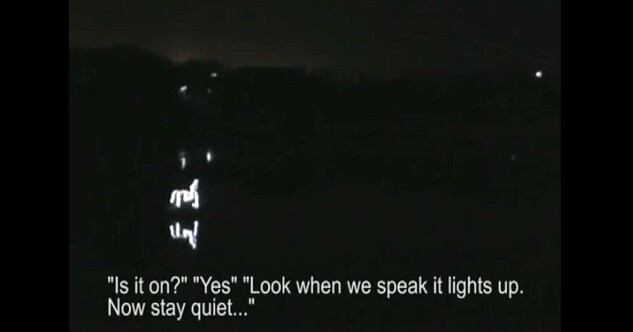

Say Hello to the Hauz
(2010), the brainchild of designer and filmmaker Vishal Rawlley, was an
attempt to revive the long-neglected water reservoir in Mehrauli, one
of the seven ancient cities that make up the state of Delhi. Drawing on
the story of the Prophet Muhammad’s ascent to heaven astride a winged
horse called Buraq, Rawlley designed a sculpture of the creature, fitted
it with a phone line and a constellation of fairy lights, and left it
to bob in the middle of the tank. People could dial in and speak; their
voices would trigger the phantasmagoria. In the night footage preserved
online, Buraq’s skeleton flashes on and off to the babble of unseen
voices. The gasps are subtitled, the curiosity palpable. What to an
outsider may have seemed an alien landing was really the portal to a
mythic past: the horse had a history here.
The hauz was built in the thirteenth century after an early
“slave sultan” of Delhi, Shamsuddin Iltutmish, dreamed he was visited by
the Prophet Muhammad astride his winged steed. In the dream, the
Prophet directed the king to a fountainhead that sprang where Buraq
struck the ground with her hoof. On waking, the story goes, Iltutmish
hurried to the site where he discovered the mark of a hoof imprinted on
the earth. Dreams were an important part of the apparatus of medieval
kingship; auspicious visions could steady a shaky crown. More, a widely
circulated hadith declared that seeing the Prophet in a dream was equal
to seeing him physically. To dream of the Prophet, then — in other
words, to be considered a direct witness to his words and deeds, which
together form the basis of Islamic law — was to be in a very privileged
position indeed, and Iltutmish acknowledged the honour with due piety:
he built a water tank, the Hauz-i-Shamsi, to mark the hallowed spot. For
centuries the tank remained a site of local devotion. Magical
properties were ascribed to its waters, and the great fourteenth-century
traveller Ibn Battuta described how small boats ferried pilgrims to the
red sandstone pavilion at its centre.
The story of the reservoir and its otherworldly aura echoes another
origin myth: that of the Hippocrene, or Horse Fountain, which sprang
from the hoof-scuff of Pegasus and is remembered in Greek mythology as a
fount of poetic inspiration. Unlike Pegasus, however, who emerged fully
formed from the blood of Medusa, Buraq’s conception was gradual, her
evolution more peculiar and circuitous. She crops up on Persian
miniatures and Pakistani trucks, Zanzibari ephemera and Libyan
airplanes, Senegalese glass paintings and Indian matchboxes. Yet despite
her many incarnations, or perhaps because of them, her essence remains
elusive. There is no original, no definitive Buraq, but rather an unruly
palimpsest of jumbled creeds, kitsch, and sheer artistic caprice.

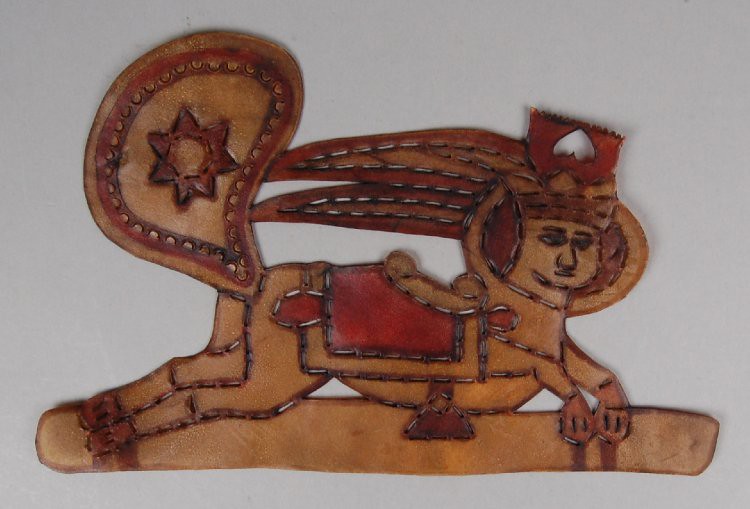
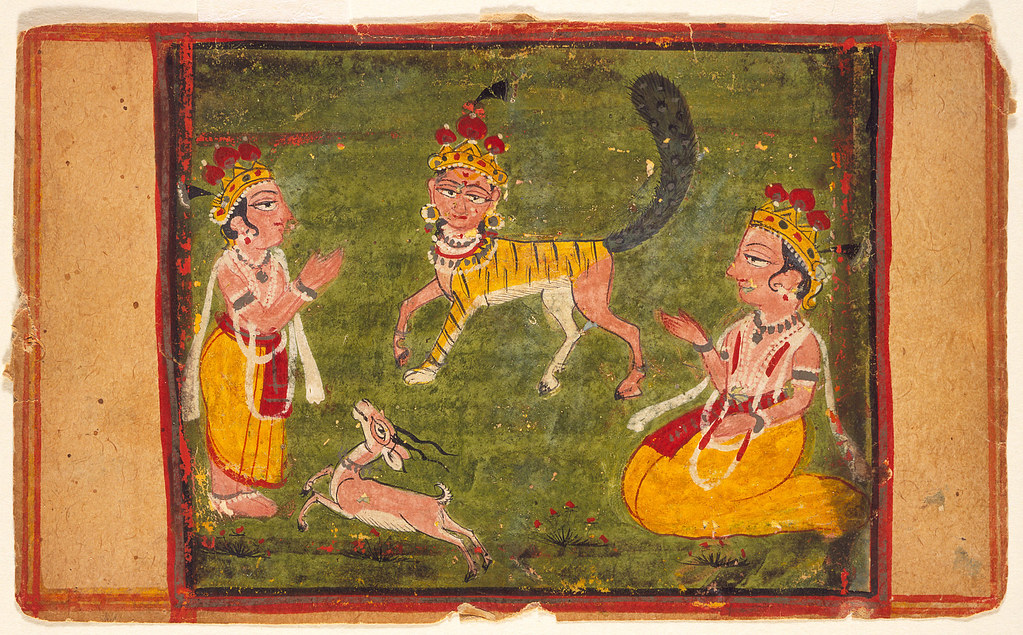
The bare bones of Buraq look like this. From the Arabic root b-r-q,
which means to shine or sparkle, her name evokes the lightning speed
with which she carried the Prophet from Mecca to Jerusalem and thereon
to heaven, an episode known as the mi‘raj, or “ascension”. The
Qur’an alludes to this journey — in two cryptic verses that lend a whole
chapter (“The Night Journey”) its title — but makes no mention of the
vehicle. Because Buraq is absent from scripture, theologians give her
short shrift, confining her to fly-by-night cameo roles: she first
appears in the eighth century, in the earliest extant biography of the
Prophet, as a “winged beast, white in colour, smaller than a mule and
larger than an ass”. Buraq is a creature not of scripture but of lore,
and in these early writings she is still a vague, unfinished thing,
uncertain of shape, let alone sex. She will take centuries to evolve a
human face: some five hundred years passed before the historian
al-Tha‘labi wrote that Buraq “had a cheek like the cheek of a human
being”, a not-quite metaphor that launched her never quite completed
metamorphosis.

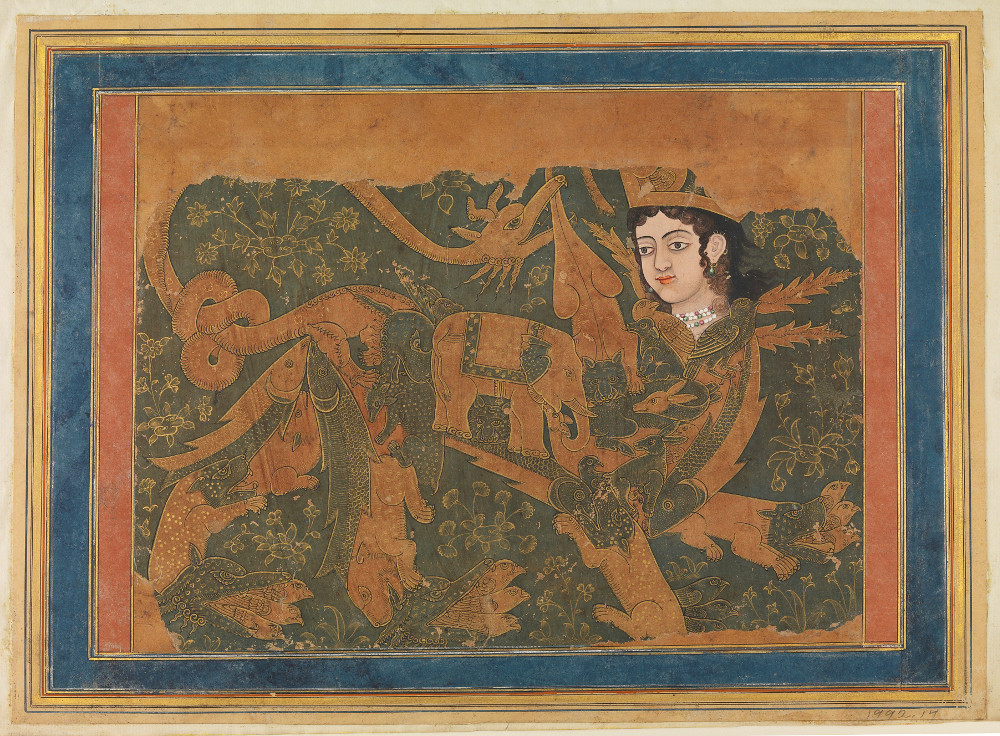
— Source.
The literature on Muhammad’s ascension to heaven grew to be enormous,
but only after it slipped its scriptural moorings and slid out into
poetry and folklore. Every life of the Prophet had a chapter on the
subject, and scholars and mystics endlessly pondered its meaning. The
story was deployed and reinterpreted among Islam’s subcultures, and also
among its foes: there are versions in Malay, Uzbek, and Old French, in
Buginese and Castilian, and a beautifully illuminated version in
Chaghatay, a form of Middle Turkish named after Genghis Khan’s second
son. Like Buraq herself, the story has never settled into a final form;
it alters every time it is told. In some accounts, the duo do not stop
at Jerusalem but venture through the seven heavens where, at the climax
of their journey, the Prophet comes face to face with God. There he
might meet a celestial rooster, or a polycephalous angel, and sometimes
he pays a visit to his mother and father in hell. In others, the Prophet
ascends to heaven by means of a glittering ladder, having fastened
Buraq to a wall at the foot of the Temple Mount. (To this day the spot
is known as the Buraq Wall to Muslims and the Western or Wailing Wall to
Jews.)
Buraq was not born a woman, she became one — but when this happened
is unclear. At some point an anonymous genius gave her a lustrous mane
and a jeweled throat, and artists have never looked back. In her many
guises classical and modern, Buraq is squarely female, adorned now with a
peacock tail, now with a leopard-print coat, almost always with a
gem-encrusted crown and brightly coloured wings. She grew into a staple
of Muslim visual art, seizing the collective imagination until writers
too followed suit. By the sixteenth century, the Persian historian
Khwandamir could write that Buraq had
a face like that of a human and ears like those of an
elephant; its mane was like the mane of a horse; its neck and tail like
those of a camel; its breast like the breast of a mule; its feet like
the feet of an ox. Its breast looked just like a ruby and its hair
resembled white armor, shining brightly by reason of its exceeding
purity.
The Persian language has no gender, obliging writers like Khwandamir
to continue to describe Buraq in neuter terms even as she gained in
feminine lustre and finery. It is perhaps no coincidence that Buraq is
most spectacularly beautified in works by Persian miniaturists, as if
these artists were giving excessively lavish expression to a femininity
their language would not allow them to convey in words — as if the
sexual restraint (the “greyness”) imposed by one medium made for an
aesthetic of sexual maximalism in another.
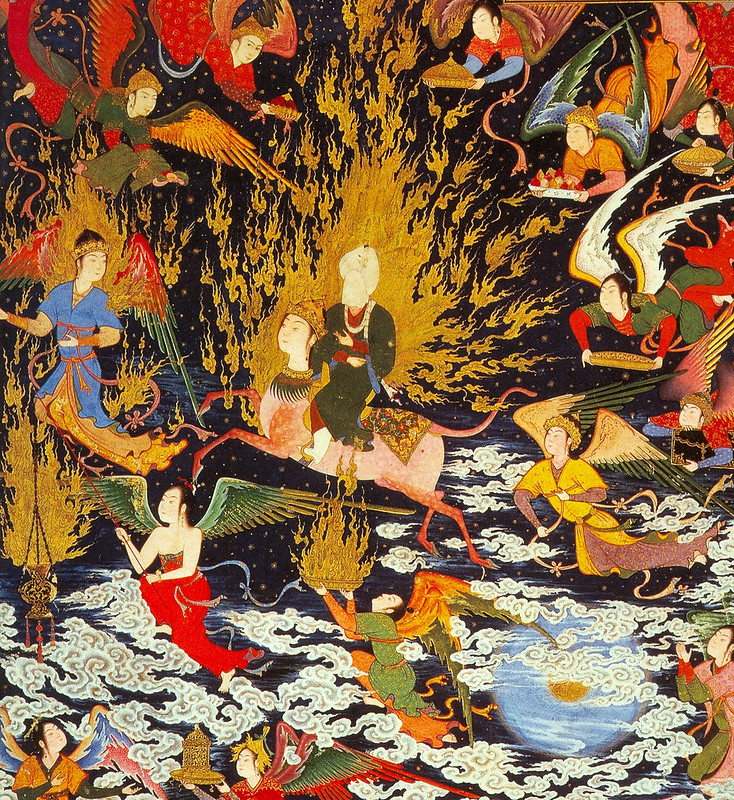
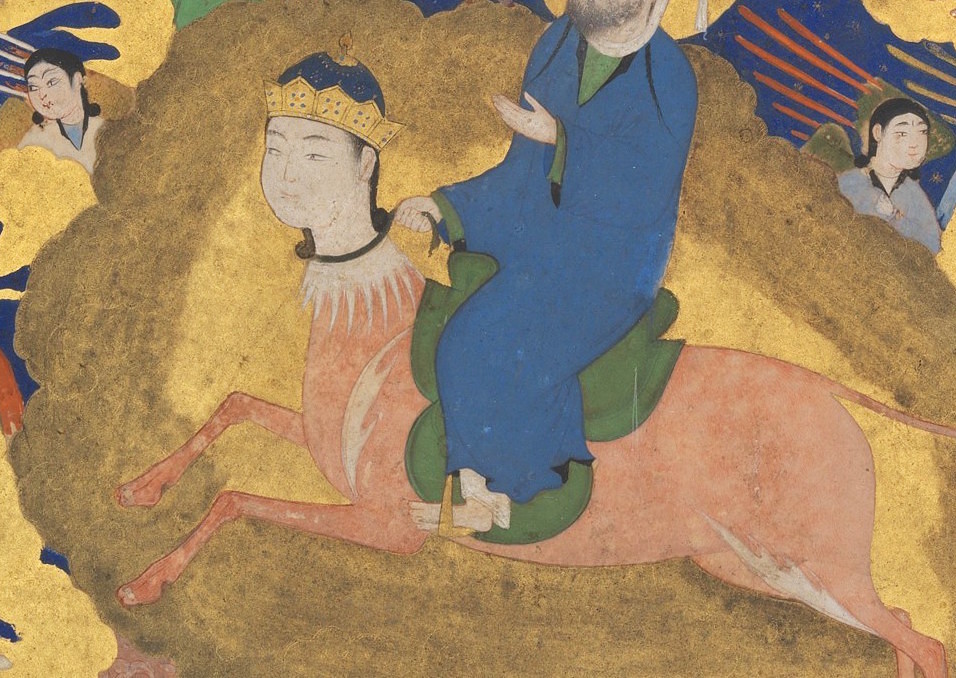
from present-day Uzbekistan and Afghanistan, probably Bukhara and Herat — Source.
If Buraq’s early, skeletal form most recalled Pegasus, the sexless
winged horse of classical antiquity, her new embellishments brought her
closer to those other feminized hybrids, Sphinx and Chimera. Gustave
Flaubert summed up the appeal of such composite, yet distinctly female
creatures: “Who has not found the Chimera charming; who has not loved
her lion’s snout, her rustling eagle’s wings, and her green-glinting
rump?” In taking on the allure of these figures, however, Buraq also
acquired a troubling ambiguity. After all, unlike those other mythical
beings, Buraq is a devotional object, theologically more akin to an
archangel than to a many-headed beast of prey. She is, existentially,
inseparable from Muhammad — she exists only to carry him on his journey —
making her feminized appearance all the more startling. Visually, they
evolve in opposite directions: the more Buraq gains in baroque
adornment, the more the figure of Muhammad seems to retreat into
allegory. As her body comes to the fore, his grows austere and
immaterial.
Bodies are everywhere in this story, and they are awkward. The
friction between the historical Prophet and his fantastical mount,
between the sacred and the physical, reflects a similar divide within
Buraq herself: she has been perceived both as a dream-horse — mythical,
sexless, emblematic — and as a creature of flesh. And Buraq as animal,
especially in her more sexualised incarnations, in turn raises thorny
questions about the body of the Prophet himself. Artists generally
elided this problem, or creatively eluded it; early images of the
Prophet tend to show him with a veil, and more recently his body has
been symbolized by a white cloud, a rose or a flame.
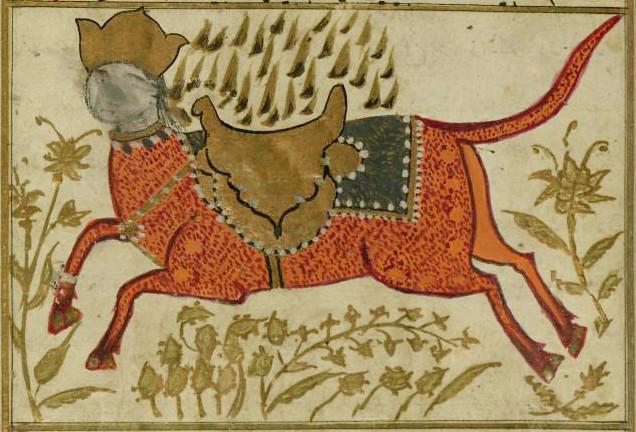
of Buraq, with the Prophet Muhammad represented by stylised flames,
from an 18th-century Ottoman manuscript, AD 1717 — Source.
Did the Prophet ascend to heaven in body or only in spirit? For all
those who grappled with the meaning of the night journey, this was a
central question. One solution was to skirt the problem of bodies
altogether. The Persian polymath Avicenna thought the mi‘raj a
purely internal, intellectual journey; less concerned with Muhammad’s
ascent than with the potential elevation of anyone engaged in abstract
thought, he used the story’s currency as a folk narrative to coax a
largely uninitiated community into the pursuit of philosophy. For
Avicenna, the ascension tale was a useful means of dispelling anxieties
about foreign intellectual traditions: by presenting these questions in
terms familiar to his Muslim audience — and by reframing the Prophet’s
ascension as a spiritual journey one should try to emulate — he showed
that the study of philosophy was not only compatible with traditional
Islamic teachings, but central to the task of the pious believer.
This sounds all very well and rational, but if bodies are erased from
the story — if the night journey was merely a voyage of the mind, a
static reverie — what is to be done with Buraq, who is pure colour and
pure form, who stands for nothing beyond her exuberant self? Avicenna
doesn’t say. The reality of the prophet’s flight is dismissed in a line
(“It is known that he did not go in the body, because the body cannot
traverse a long distance in one moment”), but winged horses are not so
easily idealised. Buraq is unavoidably, infectiously physical. Astride
her back, the Prophet is wrenched out of abstraction, trapped and
tangled up in the body of the beast as Leda by the swan in Yeats’ poem:
“and how can body, laid in that white rush / But feel the strange heart
beating where it lies?”
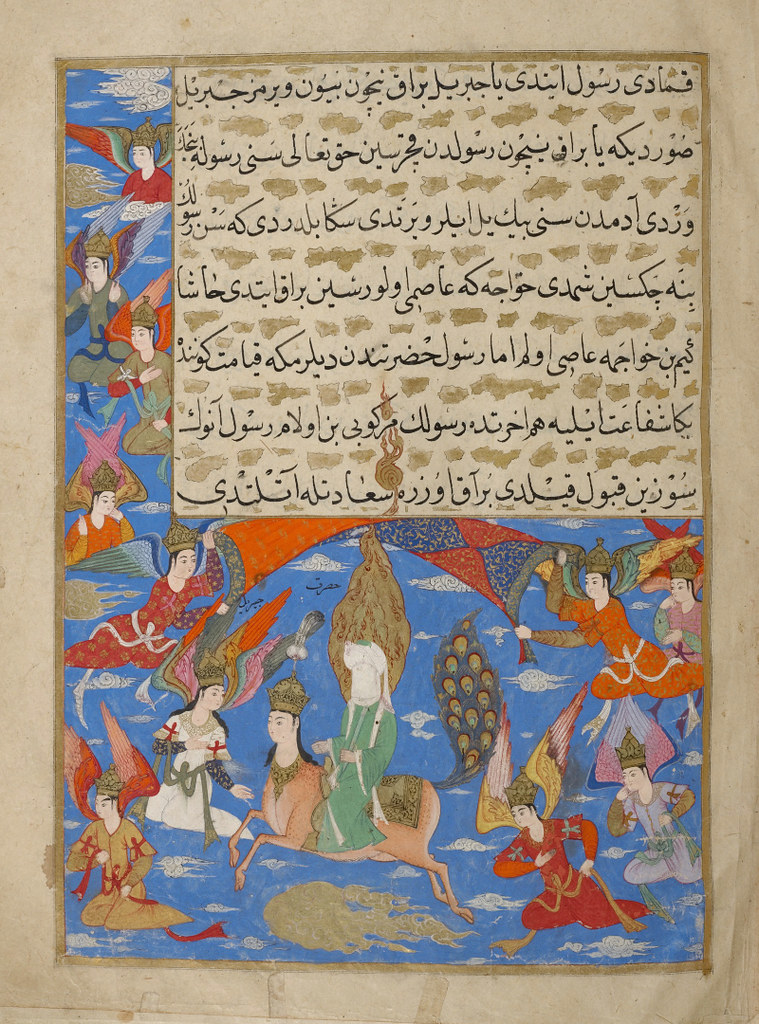
Others felt it too. The Ottoman poet Veysi was obsessed with the
physical character of the night journey, which he held to be the salient
event in Muhammad’s biography; his contribution to the genre was
accordingly titled The Life of the One Who Ascended. Veysi’s most famous work, the Habname
or Book of Dreams, takes the form of a dream conversation between
Sultan Ahmed I and Alexander the Great, and suggests a belief in the
essential fluidity between the world of dreams and real life. A similar
fluidity pervades Veysi’s account of the night journey, which stresses
the physical reality of the ascension and of the transcendental world to
which the Prophet traveled. Central to his argument are detailed
descriptions of Buraq and of the Lote Tree of the Limit, which marks the
edge of heaven and the boundary beyond which nothing can pass. The tree
has an infinite number of branches, each with an infinite number of
leaves, and on each leaf sits a huge angel carrying a staff of light. A
Sufi text calls it “a tree without description”, which grew from “an
unimaginable ocean of musk”. What sorts of things are these that are
rendered in exquisite detail yet remain “without description”, both
sensually evoked and still “unimaginable”? The clue to Buraq’s nature,
perhaps, lies in this paradox.
That Avicenna and Veysi represent seemingly irreconcilable views —
that Buraq can be considered both pure abstraction and pure physicality —
is hardly surprising; it is in her nature to divide. In its earliest
versions the ascension story functioned as a kind of shibboleth: those
who believed in Muhammad’s heavenly ascension were regarded as having
accepted his prophetic mission, whereas those who did not were deemed to
have rejected Islam itself. This problem of belief was recently revived
in a debate archived on YouTube under the title “Richard Dawkins versus
Muhammad’s Buraq horse”. The Oxford Union had invited Dawkins, the
evolutionary biologist, to share the stage with the journalist Mehdi
Hasan — Science v. Religion, firebrand against firebrand. At one point
in the video, Dawkins exclaims twice in disbelief: “You believe Muhammad
flew to heaven on a winged horse!” The crowd jeers, Hasan flounders,
and the debate grinds to a deadlock. The mere mention of Buraq — her
quaintness, her garish absurdity — was apparently enough to clinch the
argument, exposing Hasan the “believer” as irretrievably backward,
painfully naive, or a fraud.
The debate made for uncomfortable viewing. It seemed odd that among
all the mystery of religious lore, the night journey — and its
sensational metonym, the winged horse — should be singled out for
special treatment in this way. Buraq, true to her name, seems to have
become a lightning rod in the atheist crusade, a byword for the
irrationality of Islam and religion in general. Yet by posing the
question restrictively in terms of “belief”, both speakers ignored the
many ways in which believers and non-believers might engage with an
object like Buraq (in the literal sense of object, “a thing presented to
the mind”), not simply as an article of faith but as metaphor, myth,
paradox, emblem, or visual trope.

Buraq is a product of miscegenation. First found in the nineteenth
century BC, the motif of winged horses was picked up by the Assyrians,
made its way through Greece and Asia Minor, and eventually became
ubiquitous in Eurasia: Etruscans, Persians, Celts, Finns, Koreans,
Bengalis, and Tatars all boast some version of the myth. Often these
horses are able to travel at supernatural speed; they sometimes have a
human head; and they can also be linked to storms and lightning. So it
turns out that Buraq, far from being the risible cultural aberration
deplored by Dawkins, is actually a version of one of the oldest and most
widespread myths in our history, her shimmering body a receptacle for
the many myths, metaphors, and moral concerns that Islam inherited.
The world was a combination of real and mythological objects until
somewhat recently; a clear distinction could hardly be made before the
onset of modern comparative biology. And yet science has not abolished
the interstitial zone which a figure like Buraq inhabits: we need such
liminal objects to connect seemingly divergent realms of empirical and
spiritual experience. Her presence in contemporary culture acts as a
bridge between knowledge and belief, between rationalist taxonomies of
the world and the vestigial power of myth. This idea finds its most
forceful and literal expression in the Islamic transport industry, where
the figure of Buraq, usefully combining piety and speed, recurs as a
kind of patron saint. She gives her name to airlines from Libya to
Indonesia, to bus companies, freight ships and motorcycle-taxis, to a
space camp, to an engineering college, and to Pakistan’s first drone.
The fluidity of Buraq as an aesthetic and linguistic object perhaps
explain her pliability in being put to commercial use: she presides not
just over wings and wheels but is also used to sell plastic and PVC,
heavy metal and heavy-duty diesel (BURAQ LUBRICANTS), Indian food, and
surgical instruments.
The longer you study her, the deeper you dig, the more elusive
Buraq’s identity becomes. In a luminous essay, “The Chimera Herself”,
Ginevra Bompiani parses the symbolic implications of these composite
creatures. The many-headed Chimera exemplifies the arbitrary union of
countless experiences — she is the synthesis of disparate things. “She
who, in myths, was purely a fiery apparition, without a voice or a
history, was to become, in the early days of modern philosophy, the ens rationis,
the creature of language, the metaphor of metaphor”. As a hybrid, Buraq
does what metaphors do: she makes the impossible visible. “Achilles is a
lion” is literally false; you cannot figure it, yet there it is on the
page. In the basic metaphorical statement, “A is B”, Buraq plays the
same role as the copula (the “is”), brazenly flouting the law of
non-contradiction, mixing that which should not be mixed. “Since she
does not exist”, Bompiani writes, “the question arises as to what
Chimera is“. That depends, some might say, on what the meaning of the word is is.
Yasmine Seale is a writer and translator. She is reading for a PhD on Ottoman attitudes to antiquity at St John’s College, Oxford.
69) Classical Myanmar (Burmese)
69), Classical မြန်မာ (ဗမာ)
2650 Wed 13 Jun ကသင်ခန်းစာ
ယခု
105
Classic ဘာသာစကားများအတွက် http://sarvajan.ambedkar.org
မှတဆင့်အခမဲ့အွန်လိုင်းTipiṭakaသုတေသနနှင့်လေ့ကျင့်တက္ကသိုလ်နှင့်ဆက်စပ်သတင်းများ
- analytic ဝိပဿနာ Net က
Paṭisambhidāဂျာ-Abaddha
Paripanti TipiṭakaAnvesanā ca ကို Paricaya Nikhilavijjālaya CA
ñātibhūta Pavatti Nissāya http://sarvajan.ambedkar.org anto 105
SeṭṭhaganthāyattaBhāsā
တစ်ဦး Online News CHANNEL ဖြစ်ပါသည်
ကျော်ကို 3000 အီးမေးလ်များဖို့သူ့မှာအရမ်းကောင်းတဲ့:
200 WhatsApp ကို, Facebook နှင့် Twitter ။
https://dhammawiki.com/index.php/1-10_early_to_recent_Chronology_of_Pali_Canon
https://dhammawiki.com/…/1-10_early_to_recent_Chronology_of…
အစောပိုင်းပါဠိကို Canon ၏မကြာသေးခင်ကမှတ်တမ်းမှ 1-10
မိမိအဗုဒ္ဓဘာသာအိန္ဒိယနိုင်ငံတွင်သောမတ်စ်ဝီလျံ
Rhys Davids (။ p 188) မှာအောက်ပါအတိုင်းဖြစ်သည့် Ashoka
၏အချိန်မှဗုဒ္ဓ၏အချိန်ကနေဗုဒ္ဓဘာသာစာပေ၏အချိန်နဲ့တပြေးညီစားပွဲပေါ်မှာအားပေးတော်မူပြီ:
1.
ဗုဒ္ဓဘာသာအယူဝါဒ၏ရိုးရှင်းထုတ်ပြန်ချက်များယခုတူညီစကား,
အပိုဒ်တွင်သို့မဟုတ်အပေါငျးတို့သစာအုပ်တွေထဲမှာထပ်တလဲလဲကျမ်းပိုဒ်,
တွေ့ရှိခဲ့ပါတယ်။
2. ဇာတ်လမ်းတွဲများလက်ရှိစာအုပ်နှစ်ခုသို့မဟုတ်နှစ်ခုထက်ပိုသောအတွက်တူညီစကား, တွေ့ရှိခဲ့ပါတယ်။
3. သိလတို့သည် Parayana, အ Octades, အ Patimokkha ။
4. Digha, Majjhima, Anguttara နှင့် Samyutta Nikayas ။
5. အဆိုပါသုတ် Nipata, ထိုမထေရ်နှင့် Theri Gathas, အ Udanas, နှင့် Khuddaka-Patha ။
6. သုတ် Vibhanga နှင့် Khandhkas ။
7. အဆိုပါ Jatakas နှင့်တရား။
8. အဆိုပါ Niddesa, အ Itivuttakas နှင့် Patisambbhida ။
9 PETA နှင့် Vimana-Vatthus, အ Apadana, အ Cariya-Pitaka, နှင့် Buddhavamsa ။
10. ထိုအဘိဓမ္မာစာအုပ်တွေ; အရာ၏နောက်ဆုံးယင်းကတ်-Vatthu နှင့်အစောဆုံးဖြစ်နိုင် Puggala-Pannatti ဖြစ်ပါတယ်။
ထိုကဲ့သို့သောမှငါးဂဏန်းတစ်ဦးအဖြစ်ထိပ်မှာသို့မဟုတ်ထိပ်အနီးစာရင်းဝင်သောသူတို့ကို,
အစောဆုံး,
အသက်အကြီးဆုံးစာသားများနှင့်စစ်မှန်ဖြစ်အရှိဆုံးဖွယ်ရှိနှင့်ဗုဒ္ဓ၏အအတိအကျစကားလုံးများကိုထည့်သွင်းစဉ်းစားနေကြသည်။
ခေတ်သစ်ထေရဝါဒဗုဒ္ဓ၏အစောဆုံးသွန်သင်ချက်အပေါ်အလေးပေး,
သော်လည်းနောက်ပိုင်းစာသားများနှင့်မှတ်ချက်အများနှင့် Visuddhimagga,
Classical ထေရဝါဒနေဖြင့်အလွန်မြင့်မားတန်ဖိုးထားအတွက်ကျင်းပကြသည်။
ခေတ်သစ်ထေရဝါဒ
ပင်မဆောင်းပါး: ခေတ်သစ်ထေရဝါဒ
နောက်ပိုင်းစာသားများနှင့်
ပတ်သက်. သူတို့ Buddhavacana (ဗုဒ္ဓအတိအကျစကားလုံးများကို)
သို့မဟုတ်မဟုတ်ကြလျှင်ခေတ်သစ်ပညာရှင်များပြောသကဲ့သို့ရဟန်းသည်ဗောဓိ,
Dhammavuddho မထေရ်နှင့်အခြားသူများ, သူတို့ရဲ့သံသယရှိသည်။ ခေတ်သစ် Theravadins ဖြစ်ကောင်းထင်မြင်ယူဆ၏အနည်းငယ်အမျိုးမျိုးကိုင်ထားပေမယ့်ဖြစ်ကောင်းအောက်ပါများထဲမှယူ:
1.
သူတို့ရဲ့တခုလုံးကိုပထမဦးဆုံးအလေး Nikayas Buddhavacana ဖြစ်ကြသည်ပေါင်း
Khuddaka Nikaya မှအောက်ပါစာအုပ်များကို: တရား, Udana, Itivuttaka, သုတ်
Nipata, Theragatha နှင့် Therigatha; နှင့်ဝိနည်းထံမှ Patimokkha ။ (ဒါကဆဲ Tipitaka ၏ Buddhavacana သောအဘို့ကိုအကြမ်းအားဖြင့် 30 ကျော် 40 volumes ကိုထဲကလုပ်လိမ့်မယ်။ )
2.
အထက်ပါအားလုံး, ပေါင်း Khuddaka Nikaya ၏အခြားစာအုပ်များ,
ပေါင်းသည်အခြားဝိနည်းစာအုပ်များ,
ပေါင်းအဘိဓမ္မာပေမယ့်ဗုဒ္ဓအကြာတွင်တပည့်ကရေးသားအဖြစ်သူတို့ကိုမြင်,
ရဟန္တာဖြစ်နှင့်ဖြစ်ဤသို့ဆဲခံထိုက်ကြပေမည်သူကို မူရင်းဗုဒ္ဓဘာသာမဟုတ်ဖွယ်ရှိအစိတ်အပိုင်းတစ်ခုဖြစ်သော်လည်းကို Canon အတွက်ပါဝင်သည်။
အဆိုပါပညာရှင်
Ajahn Sujato နှင့် Ajahn Brahmali စာအုပ်အစောပိုင်းဗုဒ္ဓဘာသာစာသားရဲ့
Authenticity
ရေးထားပြီသူတို့အထက်အရေအတွက်ကတဦးတည်းနှင့်အတူသဘောတူညီချက်၌ရှိကြ၏,
ပထမဦးဆုံး 4 Nikayas နှင့် Buddhavacana အဖြစ် Khuddaka Nikaya
အချို့ပါဝင်သည်ဟုရဟန်းသံဃာ။
ကိုလည်းကြည့်ပါ: မူရင်းဗုဒ္ဓဘာသာ
ကိုးကား
ဗုဒ္ဓရဲ့စာရင်း၏အပြီးအစီးစာအုပ် - ရှင်းလင်းချက်။ ဒါဝိဒ်သည် N. Snyder, Ph.D ဘွဲ့ကို, 2006 ။
http://www.thedhamma.com/
အစောပိုင်းဗုဒ္ဓဘာသာကျမ်းစာသို့ဗုဒ္ဓဘာသာပြည်သူများလူ့အဖွဲ့အစည်းရဲ့စစ်မှန်မှုကို, 2014 ။
https://suttacentral.net/
dhammawiki.com
ဓမ္မဝီကီ - အစောပိုင်းပါဠိကို Canon ၏မကြာသေးခင်ကမှတ်တမ်းမှ 1-10
မိမိအဗုဒ္ဓဘာသာအိန္ဒိယနိုင်ငံတွင်သောမတ်စ်ဝီလျံ
Rhys Davids (။ p 188) မှာအောက်ပါအတိုင်းဖြစ်သည့် Ashoka
၏အချိန်မှဗုဒ္ဓ၏အချိန်ကနေဗုဒ္ဓဘာသာစာပေ၏အချိန်နဲ့တပြေးညီစားပွဲပေါ်မှာအားပေးတော်မူပြီ:
https://www.youtube.com/watch?v=N8uRJWMaPnk
https://www.youtube.com/watch?v=N8uRJWMaPnk
Pathana Pali Chant ပ႒ာန္းပါဠိေတာ္
ဖိုး ေဂၚရခါး
Published on Mar 20, 2012
Payategyi,Pathan pali chant and Metta Bhawana,Buddha Ane kazar in Myanmar by Mahar Kan Pat
Lae Sayadaw U Nanda Mitzutar
Category
Nonprofits & Activism
https://www.pariyatti.org/P%C4%81li

Pāli
Twenty-five centuries ago Pāli was the main language spoken in
northern India, the dialect in which the Buddha taught, and the language
the teachings are written in the Tipiṭaka. Pariyatti’s aim is to
provide greater access to the words of the Buddha, which will enable a
deeper understanding of the Buddha’s teaching, the Dhamma. Find
residential workshops, an online learning center, the Tipiṭaka, Pāli
books, and Pāli Word a Day email service to help strengthen your
understanding of Pāli.
Your browser does not support inline frames
____________________________________________
Your browser does not support inline frames
____________________________________________
An RSS feed of Pāli Word a Day, to use with a news aggregator,
is available using this link:
![]() Pāli Word a Day RSS.
Pāli Word a Day RSS.
More feeds are available on the
RSS feeds page.
____________________________________________
Click AppStore or Google play to download Pāli Word a Day app
bundled with Daily Words of the Buddha app.
The teachings of the Buddha are preserved in the Pāli Canon, an
extensive, detailed, systematic and analytical record. Twenty-five
centuries ago Pāli was the lingua franca of northern India, the
dialect in which the Buddha taught. Just as Sanskrit is the canonical
language of Hinduism and Latin the canonical language of Catholicism,
Pāli is the classical language in which the teachings of the Buddha have
been preserved. The Pāli sources are the Tipiṭaka (the Pali Canon); the
sub-commentaries, called the Aṭṭhakathā, Tikā and others such as Anu-tikā, Madhu-tikā, etc.
Pāli Canon
The Pāli sources are the Tipiṭaka (the Pali Canon); the
sub-commentaries, called the Aṭṭhakathā, Tikā and others such as
Anu-tikā, Madhu-tikā, etc.
70) Classical Nepali
70) शास्त्रीय नेपाली 2650 बुध 13 जुन पाठ अहिले विश्लेषणात्मकइन्साइट नेट - नि: शुल्क अनलाइन टिपीटाक रिसर्च एण्ड प्रविधि
विश्वविद्यालय र 105 क्लासिकल भाषाहरूमा http://sarvajan.ambedkar.org
मार्फत सम्बन्धित समाचार Paṭisambhidā
Jāla-Abaddha Paripanti Tipiṭaka Anvesanā ca Paricaya Nikhilavijjālaya
ca ñātibhūta Pavatti Nissāya http://sarvajan.ambedkar.org anto 105
Seṭṭhaganthāyatta Bhāsa एक अनलाइन समाचार च्यानल हो
3000 देखि अधिक इमेल को लागि खानपान:
200 व्हाट्सएप, फेसबुक र ट्विटर। https://dhammawiki.com/index.php/1-10_early_to_recent_Chronology_of_Pali_Canon https://dhammawiki.com/…/1-10_early_to_recent_Chronology_of…
1-10 पहिले पाली क्यानन को क्रान्तिको शुरुवात उनको
बौद्ध भारत (पृष्ठ 188) मा थमस विलियम राइज डेविडले बुद्ध साहित्यको बौद्ध
साहित्यको तालिकालाई बुद्धको समयमा अशोकको रूपमा दिएका छन्: 1. बौद्ध शिक्षा को सरल बयान अब, सबै शब्दहरु मा पुनरावृत्ति अनुच्छेद या पदहरुमा समान शब्दहरु मा पाइन्छ। 2. एपिसोडहरू भेटिए, समान शब्दहरूमा, अवस्थित पुस्तकहरूको दुई वा बढीमा। 3. सिलास, पराना, अक्टोड्स, पटिमोकखा। 4. दघा, मझ्हामा, अंगुरा, र सम्योटा नाकाया। 5. सता निपता, थरा र थरी गठना, उदय, र खुड्का पथ। 6. सुता विभभाङ, र खांधका। 7. जटाकस र ढम्मापाडा। 8. निडिसा, इटवाट्टास र पितिसबबहिडा। 9। पिटा र भिमा-वाटथस, अपडेना, कार्या-पिटाका, र बौद्धामा। 10. अभिषेक पुस्तकहरू; जसको अन्तिम भाग कथ-वाटौू हो, र सबैभन्दा पहिले सम्भवतः पगगला-प्याननाटी। माथिल्लो
सूचीमा माथि वा माथिको माथिल्लो सूची, जस्तै अंकहरू एक देखि पाँच, ती सबै
भन्दा पुरानो, पुरानो ग्रंथहरू र ती सबै प्रमाणहरू र बुद्धका सही शब्दहरू
मानिन्छ। पछिका
ग्रंथहरू र टिप्पणीहरू र भद्देश्यगागाहरू शास्त्रीय थेरेराडाले धेरै उच्च
सम्मानमा राख्छन्, जबकि आधुनिक थेरैडाडा बुद्धका सबैभन्दा प्रारम्भिक
शिक्षाहरूमा ध्यान दिन्छन्।
आधुनिक थेरेवाडा मुख्य लेख: आधुनिक थेरेवडा Bhikkhu
Bodhi, धम्मवौधो थरा र अरूसँग उनीहरूको संदेह छ, पछिका ग्रंथहरू जस्तै
पछिल्ला ग्रन्थहरू र यदि तिनीहरू बौद्धाण्य हुन् (बुद्धको सही शब्द) वा
होइन। आधुनिक थियेडेनियन्सले विभिन्न प्रकारको प्रतिक्रियाहरू राखेका छन् तर शायद निम्न मध्ये एक लिन्छन्: 1.
पहिलो सम्पूर्ण नेकाहरू बौद्धका हुन्, साथै खाडाका निकयाका निम्न
पुस्तकहरू: ढम्मपाडा, उडाना, इटिभटक, सुत्ता निपाता, थेरेगाथा र थरिगुता; र विनाया देखि पतमोकखा। (त्यो अझै पनि Tipitaka को बौवाकाना भाग लगभग 40 मात्रा मध्ये लगभग 30 हुनेछ।) 2.
माथिको सबै, प्लस खड्का निक्याका अन्य पुस्तकहरू, साथै अन्य विनाया
पुस्तकहरू, साथै अभहिम्मा, तर उनीहरूलाई बुद्धका पछिल्ला चेलाहरू द्वारा
लिखित रूपमा हेर्नुहोस्, जसले आह्वान गरेका थिए र यसरी, अझै पनि योग्य हुन
सक्दछ। कैननमा समावेश, यद्यपि सम्भावना नभएको बौद्ध धर्मको अंश। विद्वान
भिक्षु अजहान सुजुतो र अजह ब्रह्मलीले प्रारम्भिक बौद्ध ग्रंथहरूको
प्रमाण पत्र लेखेका छन् र उनीहरूको संख्या एक माथिको सम्झौतामा रहेको छ,
पहिलो 4 नेक्य र केहि खाडाका नलिकालाई बौद्धाणा भनिन्छ। यो पनि हेर्नुहोस: मूल बौद्धता
सन्दर्भहरू बुद्धको सूचीहरूको पूर्ण पुस्तक - व्याख्या गरिएको। डेभीड एन। सिनेडर, पीएच.डी., 2006।
http://www.thedhamma.com/
प्रारम्भिक बौद्ध ग्रन्थहरूको बौद्धिकता बौद्ध प्रकाशन समाज, 2014।
https://suttacentral.net/
dhammawiki.com
1-10 को शुरुवात सम्म पली कैनन - धम्मा विकी को क्रान्ति
उनको
बौद्ध भारत (पृष्ठ 188) मा थमस विलियम राइज डेविडले बुद्ध साहित्यको बौद्ध
साहित्यको तालिकालाई बुद्धको समयमा अशोकको रूपमा दिएका छन्:

https://www.youtube.com/watch…
Jahan Chan Buddha Ka Ankhan (Nepali)
Ricky Shrestha
Published on Dec 6, 2007
Another favorite song..
Category
Entertainment
Insight Net - GRATIS Online Tipiṭaka Research and Practice University
og relaterte NYHETER gjennom http://sarvajan.ambedkar.org i 105
KLASSISKE SPRÅK Paṭisambhidā
Jāla-Abaddha Paripanti Tipiṭaka Anvesanā ca Parikaya Nikhilavijjālaya
ca ñātibhūta Pavatti Nissāya http://sarvajan.ambedkar.org anto 105
Seṭṭhaganthāyatta Bhāsā er en online nyhetskanal
Catering til mer enn 3000 e-poster:
200 WhatsApp, Facebook og Twitter. https://dhammawiki.com/index.php/1-10_early_to_recent_Chronology_of_Pali_Canon https://dhammawiki.com/…/1-10_early_to_recent_Chronology_of…
1-10 tidlig til siste kronologi av Pali Canon Thomas
William Rhys Davids i sitt buddhistiske India (s. 188) har gitt et
kronologisk bord av buddhistisk litteratur fra Buddha-tiden til Ashoka
som er som følger: 1. De enkle utsagnene om buddhistisk doktrin fant nå, i identiske ord, i avsnitt eller vers som er tilbake i alle bøkene. 2. Episoder funnet i identiske ord i to eller flere av de eksisterende bøkene. 3. Silas, Parayana, Octadene, Patimokkha. 4. Digha, Majjhima, Anguttara og Samyutta Nikayas. 5. Sutta Nipata, Thera og Theri Gathas, Udanas og Khuddaka Patha. 6. Sutta Vibhanga og Khandhkas. 7. Jatakas og Dhammapadas. 8. Niddesa, Itivuttakas og Patisambbhida. 9. Peta og Vimana-Vatthus, Apadana, Cariya-Pitaka og Buddhavamsa. 10. Abhidhamma bøkene; Den siste er Katha-Vatthu, og den tidligste sannsynligvis Puggala-Pannatti. De
som er oppført øverst eller nær toppen, for eksempel tallene 1-5,
regnes som de tidligste, eldste teksten og mest sannsynlig å være
autentiske og Buddhas eksakte ord. De
senere tekster og kommentarene og Visuddhimagga holdes i stor grad av
klassisk Theravada, mens den moderne Theravada fokuserer på Buddhas
tidligste lære.
Moderne Theravada Hovedartikkel: Modern Theravada Bhikkhu
Bodhi, Dhammavuddho Thera og andre har sine tvil, som moderne lærde om
senere tekster, og om de er Buddhavacana (eksakte Buddha-ord) eller
ikke. Moderne Theravadins inneholder sannsynligvis et lite utvalg meninger, men sannsynligvis ta ett av følgende: 1.
De første fire Nikayaene i sin helhet er Buddhavacana, pluss følgende
bøker fra Khuddaka Nikaya: Dhammapada, Udana, Itivuttaka, Sutta Nipata,
Theragatha og Therigatha; og Patimokkha fra Vinaya. (Det vil fortsatt gjøre Buddhavacana-delen av Tipitaka omtrent 30 av 40 volumer.) 2.
Alt ovenfor, pluss de andre bøkene til Khuddaka Nikaya, pluss de andre
Vinaya-bøkene, pluss Abhidhamma, men se dem som skrevet av senere
Buddhas disipler, som kanskje har vært arahanter og dermed fortsatt
verdige til å være inkludert i kanon, men ikke sannsynlig del av opprinnelig buddhisme. De
lærde munkene Ajahn Sujato og Ajahn Brahmali har skrevet boken
Authenticity of Early Buddhist Texts, og de er enige med nummer ett
over, bestående av de første 4 Nikayasene og noen av Khuddaka Nikaya som
Buddhavacana. Se også: Original Buddhism
referanser Den komplette boken av Buddhas lister - forklart. David N. Snyder, Ph.D., 2006.
http://www.thedhamma.com/
Autentisiteten til buddhistiske publikasjonssamfunnet for tidlig buddhistiske tekster, 2014.
https://suttacentral.net/
dhammawiki.com
1-10 tidlig til siste kronologi av Pali Canon - Dhamma Wiki
Thomas
William Rhys Davids i sitt buddhistiske India (s. 188) har gitt et
kronologisk bord av buddhistisk litteratur fra Buddha-tiden til Ashoka
som er som følger:

https://www.youtube.com/watch?v=P4HnqxXKJvM
Pchum Ben Ceremony, Khmer Buddhist Center, NORWAY, 16-9-2017
Nokor K.
Published on Sep 29, 2017
Pchum Ben Ceremony, Khmer Buddhist Center, NORWAY, 16-9-2017
Category
News & Politics

https://dhammawiki.com/…/1-10_
1-10 early to recent Chronology of Pali Canon
Thomas William Rhys Davids in his Buddhist India (p. 188) has given a
chronological table of Buddhist literature from the time of the Buddha
to the time of Ashoka which is as follows:
1. The simple statements of Buddhist doctrine now found, in identical
words, in paragraphs or verses recurring in all the books.
2. Episodes found, in identical words, in two or more of the existing books.
3. The Silas, the Parayana, the Octades, the Patimokkha.
4. The Digha, Majjhima, Anguttara, and Samyutta Nikayas.
5. The Sutta Nipata, the Thera and Theri Gathas, the Udanas, and the Khuddaka Patha.
6. The Sutta Vibhanga, and Khandhkas.
7. The Jatakas and the Dhammapadas.
8. The Niddesa, the Itivuttakas and the Patisambbhida.
9. The Peta and Vimana-Vatthus, the Apadana, the Cariya-Pitaka, and the Buddhavamsa.
10. The Abhidhamma books; the last of which is the Katha-Vatthu, and the earliest probably the Puggala-Pannatti.
Those listed at the top or near the top, such as numbers one to five,
are considered the earliest, oldest texts and the most likely to be
authentic and the exact words of the Buddha. The later texts and the
commentaries and the Visuddhimagga, are held in very high esteem by
Classical Theravada, whereas, the Modern Theravada focuses on the
earliest teachings of the Buddha.
Modern Theravada
Main article: Modern Theravada
Bhikkhu Bodhi, Dhammavuddho Thera and others have their doubts, as do
modern scholars about the later texts and if they are Buddhavacana
(exact words of Buddha) or not. Modern Theravadins probably hold a
slight variety of opinions but probably take one of the following:
1. The first four Nikayas in their entirety are Buddhavacana, plus the
following books from the Khuddaka Nikaya: Dhammapada, Udana, Itivuttaka,
Sutta Nipata, Theragatha, and Therigatha; and the Patimokkha from the
Vinaya. (That would still make the Buddhavacana portion of the Tipitaka
roughly 30 out of 40 volumes.)
2. All of the above, plus the
other books of the Khuddaka Nikaya, plus the other Vinaya books, plus
the Abhidhamma, but see them as written by later disciples of the
Buddha, who may have been arahants and thus, still worthy to be included
in the Canon, although not likely part of Original Buddhism.
The
scholar monks Ajahn Sujato and Ajahn Brahmali have written the book The
Authenticity of Early Buddhist Texts and they are in agreement with
number one above, consisting of the first 4 Nikayas and some of the
Khuddaka Nikaya as Buddhavacana.
See also: Original Buddhism
References
http://www.thedhamma.com/
The Authenticity of Early Buddhist Texts Buddhist Publication Society, 2014.
https://suttacentral.net/
dhammawiki.com
1-10 early to recent Chronology of Pali Canon - Dhamma Wiki
Thomas
William Rhys Davids in his Buddhist India (p. 188) has given a
chronological table of Buddhist literature from the time of the Buddha
to the time of Ashoka which is as follows:
Now Analytic Insight Net - FREE Online Tipiṭaka Research and Practice
University and related NEWS through http://sarvajan.ambedkar.org in
105 CLASSICAL LANGUAGES
an Online GOOD NEWS CHANNEL FOR WELFARE, HAPPINESS AND PEACE FOR ALL
SOCIETIES Catering to more than 3000 Emails: 200 WhatsApp, Facebook and
Twitter.
Saheb Kanshi Ram @SahebKanshiRam


















